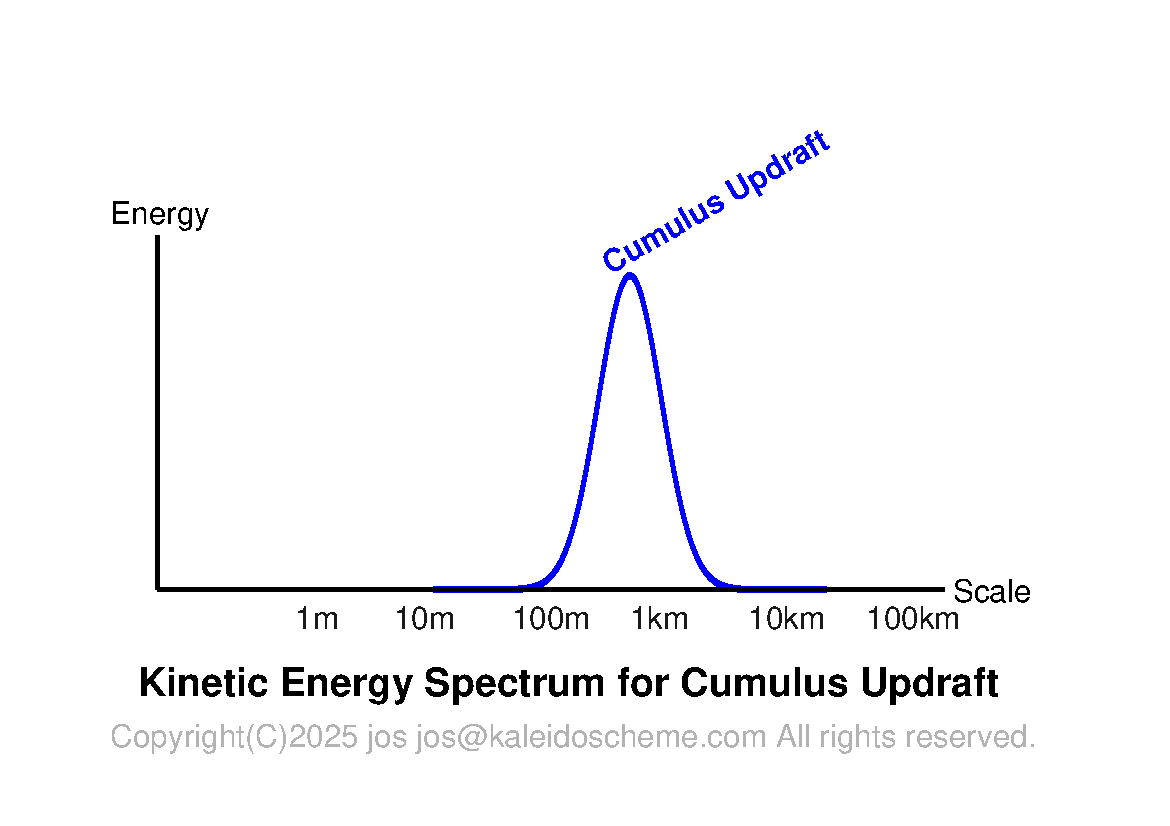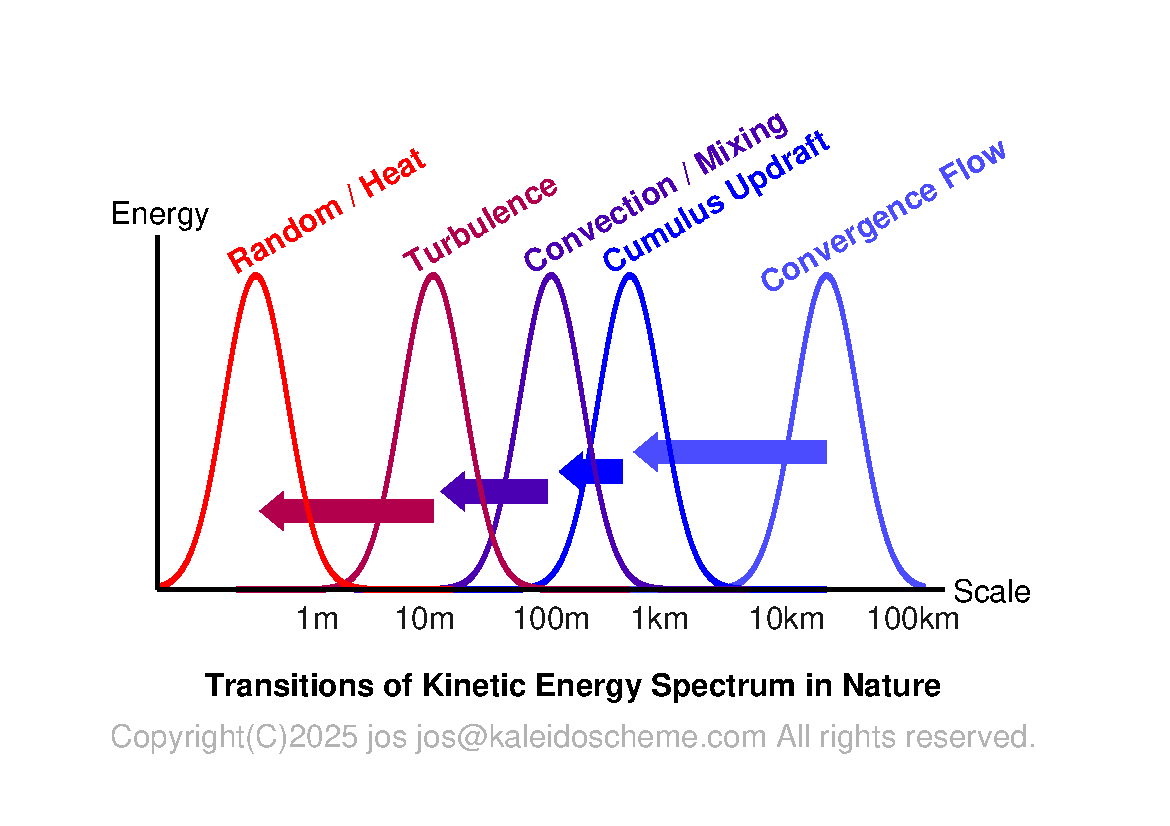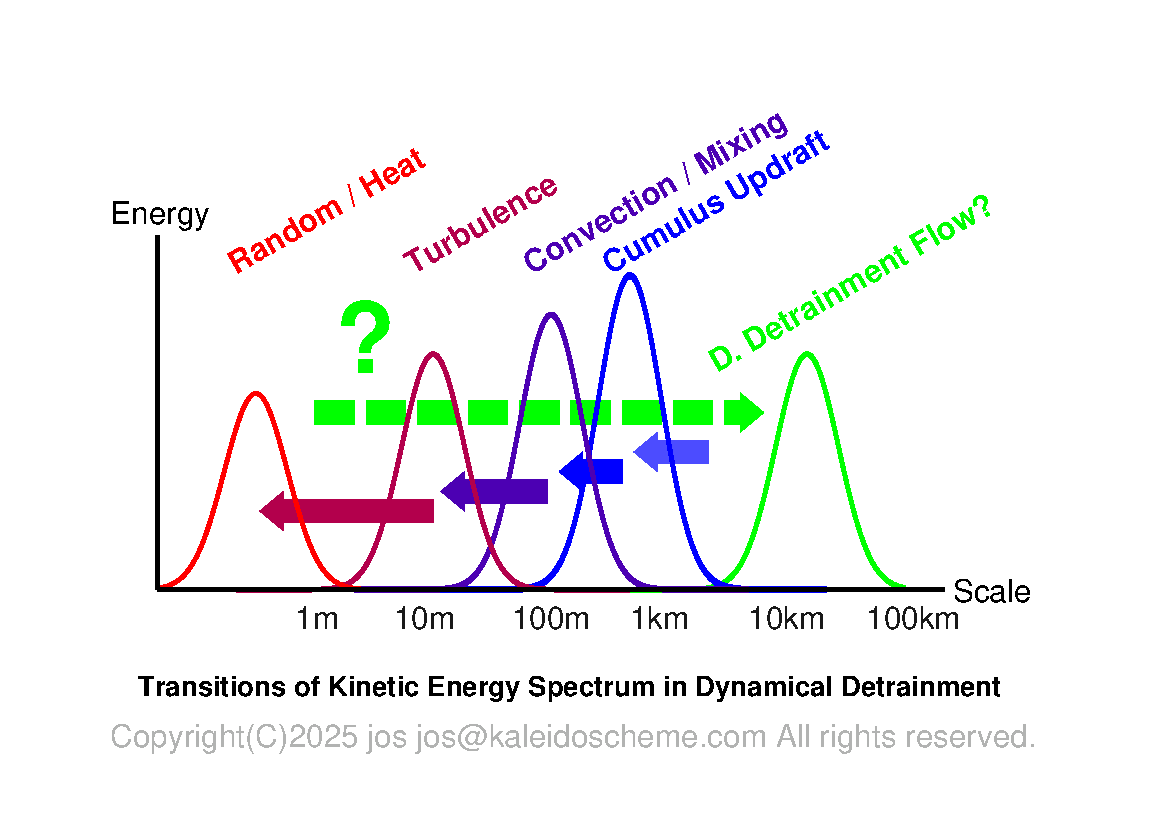
Transitions of Kinetic Energy Spectrum < rdctheory.cloud
The contents of this page are edited based on the Tweet/X thread dated 22 April 2025.
We have always maintained that the DD method violates the second law of thermodynamics. But you don't seem to realize this, so we will explain it using the transitions of the kinetic energy spectrum, which can be clearly visualized.

Figure TKES-1 shows the kinetic energy spectrum for the spatial scale of a moist thermal plume in an early stage of cumulus development. The peak is located at about 1 km, which is a typical radius for a cumulus cloud. Let's look at its temporal transitions.

Figure TKES-2 shows the time transition of the kinetic energy spectrum of a cumulus cloud in nature.
Here, we have assumed a solitary cumulus cloud, so the convergence flow is shown as having a large spatial scale (the right-most lightblue spectrum). However, even convergence flows at smaller meso-scale always have a spatial scale larger than cumulus clouds.
Starting from a convergence flow, the cumulus convection flow progressively transitions to smaller flows, eventually reaching heat, which is random molecular motion. A flow on a larger spatial scale will always transition to a flow on a smaller spatial scale (the LEFT-directed arrows). The second law of thermodynamics guarantees the direction of this natural transition. Transitions in the opposite direction never occur.
[NOTE]
If you regard that the convergence flow and the cumulus updraft occur simultaneously,
you can EITHER ignore the energy spectrum of the convergence flow
and begin with that of the cumulus updraft,
OR,
integrate these two energy spectra into a single spectrum with a large width.
In any case, the story stays the same.

Figure TKES-3 is the same figure but for the case of Dynamical Detrainment. Somewhere in the stages where the cumulus flow changes to smaller scales, a reverse transition (the RIGHT-directed dashed green arrow) occurs and a detrainment flow larger than the cumulus is formed. It is distinctly different from the other transitions.
This problem has a clear border: the wall of the cumulus flank, which is approximately one to two kilometers in diameter. The flow of the cumulus convection is always smaller than this border. Conversely, the detrainment flow is always larger than this border. It's obvious.
Such a reverse transition is never allowed by the second law of thermodynamics. With enormous energy and a deliberate structure, it might be possible to increase the scale of the flow ENGINEERINGLY. In an open atmosphere, however, there is no structure and the heating due to latent heat release merely enhances mixing.
Intuitively, Dynamical Detrainment looks plausible. In the complex computations, it is easy to lose sight of the essence of the problem. But if we follow the transition of kinetic energy as shown here, we can see that it is impossible IN PRINCIPLE. It is no exaggeration to say that Boltzmann left us the second law of thermodynamics just to determine this cumulus detrainment problem objectively, rather than relying on intuition.
You may imagine the process of upward mass flux supplied from the cloud base flowing out of the cumulus at some altitude DYNAMICALLY. However, this cannot be realized without assuming laminar flow. In real air, such flow, which resolves convective instability, is immediately converted into useless turbulence. The bumpy pattern on the surface of the cumulus cloud is the proof. The size of each bump indicates the size of the turbulent flow in the cumulus. Even if there is laminar flow in the cumulus, the outflow generated by the laminar flow is limited to the same scale as the scale of the laminar flow, and no outflow to a larger scale can be generated by the dynamics. And, even if such forced laminar flow could get out of the cumulus, it would be immediately converted to turbulence in the open air. Such dynamically forced flow has no significant transport effect outside of the cumulus.
Even if the DD supporters claim that they pay attention to maintaining entropy increase during the DD generation process, they are talking about just a part in the whole process. It is clear that DD violates the 2nd law, as shown in Fig. TKES-3, the small-scaled turbulent internal flow within the cumulus cloud ultimately results in laminar flow extending beyond the scale of the cloud and into the ambient atmosphere. However complex processes are introduced, the reverse transition of the kinetic energy spectrum could not be avoidable as long as they are based on dynamics of cumulus convection.
Note that our rejection is not aimed at a specific implementation, but applies to ANY kind of detrainment method that relies on the dynamic flow in the cumulus. This problem arises as long as one tries to consider detrainment flow within a set of dynamics. Cumulus detrainment flow should be considered separately from the dynamics framework. If we consider the detrainment flow as an RDC, which is not dynamics but kinematics in the surrounding atmosphere, then all the flow and mechanism can be treated on the same scale, which is larger than the cumulus. This does not violate the second law of thermodynamics. Please examine the RDC scheme.
Researchers would reject such basic arguments as too simplistic. If so, they should refute this naive argument with the expertise on which they base their arguments. Otherwise, the current predictions of global warming using the DD method are fundamentally nonsense. This is because cumulus detrainment is not a small effect on global warming, but the mechanism for water vapor feedback that determines its main driver, the radiation budget.
We invite you to contact us immediately to begin our RDC scheme collaborations as soon as possible. We look forward to your serious consideration.
Transitions of Kinetic Energy Spectrum < rdctheory.cloud
Exhibited on 2025/04/22
Last updated on 2025/10/14
Copyright(C)2025 jos <jos@kaleidoscheme.com> All rights reserved.